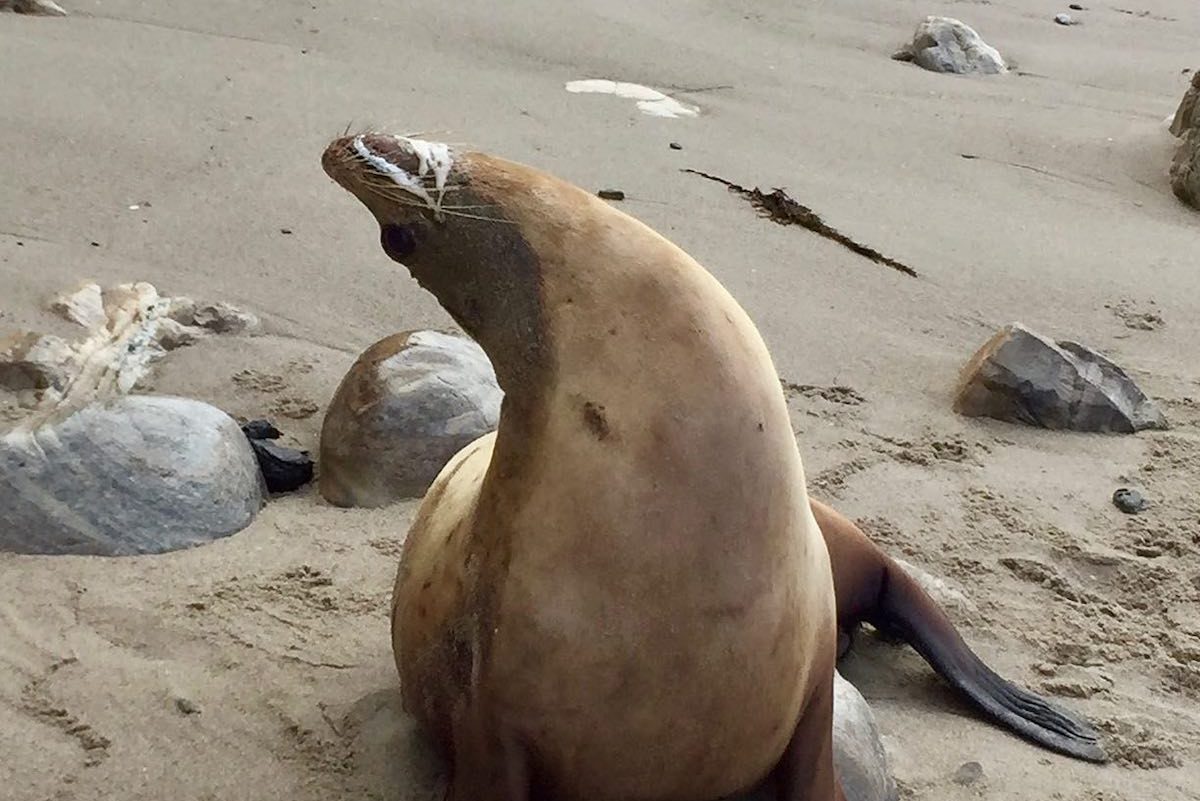Santa Barbara Channel Sightings: The Red Tide and Great Whites
Sea Lions and Dolphins Sick and Dying; Baby Sharks Swim Near Beaches

[Updated: Tue., June 20, 2023, 1:23pm]
A harmful algae bloom off the coasts of Santa Barbara and Ventura counties is poisoning an alarming number of California sea lions and dolphins that have washed up on the shoreline since May. Hundreds of distressed beachgoers have called the Channel Islands Marine & Wildlife Institute (CIMWI) to report dead and sick animals along local beaches. A surge of such reports occurred last week.
The nonprofit institute said the majority of calls they received are about sea lions showing signs of domoic acid toxicity — the acid is a naturally occurring neurotoxin produced by blooms of algae, typically in spring or fall, also known as the “red tide.” Marine mammals and seabirds become sick after eating small prey that feed on the algae blooms but are not affected by the toxin. The large animals can experience brain lesions, hippocampus shrinking, and even death, according to CIMWI.
In the first weeks of June, the toxin is suspected to have killed hundreds of California sea lions and close to 60 dolphins, according to the National Oceanic and Atmospheric Administration.
On Tuesday, June 13, CIMWI staff and volunteers managed more than 200 reports of animals in distress, including nine live dolphins and 25 sick sea lions. “We are doing the best we can to keep up with this intense pace,” the institute said in an Instagram post on Wednesday, which showed television coverage of volunteer efforts.
“We are currently inundated with domoic acid sea lions and dolphins,” CIMWI Executive Director Sam Dover told the Indy on June 17. “We are receiving 30-60 calls per hour and responding to over 30 animals per day.”
Affected animals exhibit unusual behaviors such as head swaying back and forth, foaming at the mouth, or seizure activity, and beachgoers are advised to keep their distance and report any sightings to CIMWI’s rescue hotline at (805) 567-1505.
Leadbetter, Padaro, Isla Vista, Haskells, and Rincon are some of the beaches where recent animal strandings were reported. Volunteers are dispatched to the locations to determine if rescue is possible, monitor parameters, and educate the public as needed.
While no cure exists, many sea lions with acute toxicosis can recover and survive, either on their own or with the help of CIMWI veterinarians at the nonprofit’s Gaviota Coast rehabilitation center. However, the same cannot be said for the common dolphins that succumb to the illness, most of which die before volunteers reach them.
The Red Tide Cometh
Although disturbing to witness, the blooms themselves are nothing new. Harmful algal bloom events were recorded in Southern California in 2002, 2006, 2007, 2017, and 2022.
But last year, from August 15 to September 21, CIMWI experienced an unprecedented domoic acid event affecting marine mammals. Over a 37-day period, CIMWI responded to 262 individual cases, with an average of six new cases per day. CIMWI also received 1,816 reports and rescued 70 marine mammals affected by domoic acid. This year’s numbers are already looking like they will be as high, if not higher.
The events have increased in frequency and severity in recent decades, potentially due to climate change and increased nutrient pollution. However, CIMWI says that by monitoring toxic blooms and sick and stranded animals, researchers can devise early warning systems to protect wildlife, marine ecosystems, and even prevent human illness.
Baby Sharky, Sharky, Sharky
On a (debatably) more positive note, great white sharks have been thriving in Southern California waters in recent years, according to a new study from Cal State Long Beach’s Shark Lab. Santa Barbara/Hawaii environmental nonprofit Reef Guardians have been monitoring the young sharks since 2016, and invited Shark Lab director and researcher Dr. Chis Lowe to study alongside them and add to their Southern California research.
During a sold-out event on Saturday, Lowe, Board Chair Harry Rabin of Reef Guardians, and Carlos Gauna, “The Malibu Artist,” presented findings of newly observed behavior among great whites, as well as gorgeous drone footage of the creatures elegantly moving through the waters off of Santa Barbara’s coast.

Southern Santa Barbara County, mostly around Carpinteria, acted as a nursery for juvenile sharks over the past two years, researchers found. Although the sharks would often get up close and personal with blissfully unaware humans, surprisingly, nothing happened. The sharks did not seem to care about the people floating just a few feet away from them, and they were seen swimming together about 97 percent of the time.
According to Reef Guardians, juvenile great whites have been observed entering the local nursery area during springtime. However, researchers believe the red tides — which have arrived around mid-May over the last two years — cause the juveniles to leave Santa Barbara’s coastline and head further south. From there, they may return to the nursery later in the summer.




You must be logged in to post a comment.